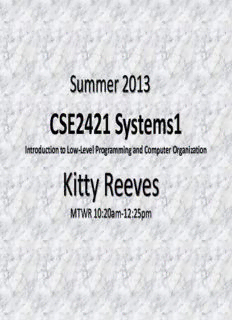
Pointer Arithmetic PDF
Preview Pointer Arithmetic
Summer 2013 CSE2421 Systems1 Introduction to Low-Level Programming and Computer Organization Kitty Reeves MTWR 10:20am-12:25pm 1 Understanding Pointers See page 252 of systems book http://boredzo.org/pointers/ http://bitcrafters- appledev.blogspot.com/2012/06/c-arrays- and-pointers-cheat-sheet.html http://www.c-for- dummies.com/caio/pointer-cheatsheet.php 2 Pointer introduction Address 1001: The system address in memory knows where the var variable Value is located variable (symbol table) int var = 50; // int *ptr, i; // i is an integer variable ptr = &var; // *ptr == var i = *ptr; // *ptr = 1; // var == 1 3 Key points about pointers A pointer is a memory address Every pointer has an associated type Every pointer has a value NULL indicates that a pointer does not point anywhere Pointers are given a value with the & operator Pointers are dereferenced with the * operator Get the value at that address Arrays and pointers are closely related Casting from one type of pointer to another changes its type but not its value Pointers can also point to functions 4 Pointer definition Values of variables are stored in memory, at a particular location A location is identified and referenced with an address Analogous to identifying a house’s location via an address A pointer is a variable that contains the address of another variable * is used in the declaration of a pointer type int *p means variable p is a pointer that points to an integer & (unary operator) gives the “address of” an object p = &c means the address of c is assigned to the variable p * (unary not arithmetic operator) is a dereferencing operator when applied to pointers When applied to a pointer, it accesses the object the pointer points to * in front of a pointer variable means “get the value at that address” i.e. “contents of” int a = *p means get the value at the address designated by p and assign it to a *p = 1 means assign the value of 1 to the memory location designated by the address of p Every pointer points to a specific data type Exception = void (a generic pointer); pointer to void holds any type of pointer but can’t be dereferenced (i.e. cannot get the “contents of”) Ah, yes. POINTERS. At last, we arrive at THE MOST DREADED WORD in the lexicon of the C student. Pointers are indeed so dreaded that Java has completely done away with pointers and wrapped their functionality into the (admittedly safer) concept of references. C++, as a transitional step, has both pointers and references. 5 Declaring Pointers int* ptr_a; int *ptr_a; The first style leads to mistakes int* ptr_b, ptr_c, ptr_d b is a pointer but c and d are integers int *ptr_b, *ptr_c, *ptr_d 3 pointers are declared here Char example char ch = 'c'; char *chptr = &ch; char *ptr = chptr; Both chptr and ptr have the same initial value 6 Pointer example Reminders: * in a declaration says “I am a pointer” that points to a certain type of value & “address of” * In front of a pointer type says “get the value at that address” i.e. “contents of” operator ADDRESS (in MEMORY (assuming 4 bytes per word VARIABLE decimal) and each block is a byte)* ip 0 Is a pointer; holds an addr; 8… 16 4 x 8 1… 0 EXAMPLE: y 12 2… 1 int x=1, y=2, z[10]; z 16 z[0] int *ip; 20 z[1] 24 z[2] ip = &x; 28 etc y = *ip; 32 *ip = 0; 36 40 ip = &z[0]; 44 * not going to worry about "size" right now 7 Pointer examples… more! Every pointer points to a specific data type. one exception: a ‘‘pointer to void’’ is used to hold any type of pointer but cannot be dereferenced itself If ip points to the integer x (ip=&x) then *ip can occur in any context where x could Example: *ip = *ip + 10 x=x+10; increments the contents of the address at ip by 10 The unary operators * and & bind more tightly than arithmetic operators Example: y = *ip + 1 takes whatever ip points at, adds 1, and assigns the result to y Other ways to increment by 1: *ip += 1 *ip = *ip + 1 Is it okay to *ip++? ++*ip (*ip)++ The parentheses are necessary; without them, the expression would increment ip instead of what it points to, because unary operators like * and ++ associate right to left. Pointers are variables so can be used without dereferencing. Example: int x, *iq, *ip=&x; iq = ip; copies the contents of ip (an address) into iq, making iq point to whatever ip points to 8 REMINDER: Every pointer points to a specific data type EXCEPTION: You try… void (a generic pointer); pointer to void holds any type of pointer but can’t be dereferenced (i.e. cannot get the “contents of”) /* EXAMPLE 1 */ /* EXAMPLE 2 */ #include<stdio.h> #include <stdio.h> Void parameter int main() { #include <stdlib.h> means there are float i=10, *j; main() { no arguments void *k; int x, *p; k=&i; p = &x; /* EXAMPLE 3 */ j=k; *p = 0; #include <stdio.h> printf("%f\n", *j); printf("x is %d\n", x); int main(void) { return 0; } printf("*p is %d\n", *p); char ch = 'c'; *p += 1; char *chptr = &ch; printf("x is %d\n", x); int i = 20; (*p)++; int *intptr = &i; printf("x is %d\n", x); float f = 1.20000; return 0; } float *fptr = &f; char *ptr = "I am a string"; printf("\n [%c], [%d], [%f], [%c], [%s]\n", *chptr, *intptr, *fptr, *ptr, ptr); return 0; } 9 Pointer Review – In Class Asgnmnt 10
Description: